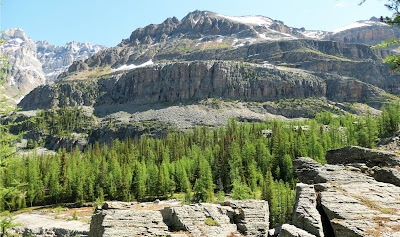Our goal on July 16th was to climb to Paget Lookout, which Joan and I had only visited once before -- in 2012! The first part of the trail serves two destinations: Paget Lookout and Sherbrooke Lake. (Click on any image to enlarge.)Across from the parking area and Wapta Lake runs the Canadian Pacific railroad.The trail climbed steadily, with flowers along the way.On reaching the intersection, we took the right-hand path,
and the flowers continued -- for a while.The trail grew steadily steeper and narrower, and the foliage began to change; after all, the lookout is 2,000' above the parking lot. Here are some flourishing pine cones.The view began to unfold as we huffed, puffed, sweated, and pushed on our hiking poles. We could see Kicking Horse Pass and, beyond it, the flatter lands around the town of Field and its Canadian Pacific train yard.On the far-side slopes above Sherbrooke Lake, the geological stresses of the past are evident.The trees thinned and the sun grew hotter. This was real work! Then the old lookout hove into view.Below the hut lay a bench composed of three aging slalom boards. Here's a panoramic photo looking outward; the two segments composing it were taken from slightly different positions, so you may notice a few discontinuities. 😎Other hikers came up. We had some good chats, particularly with two young women who have been working in Golden, about twenty miles southwest of Field, for five years. One was Dutch, and the other Quebecois.
Some continued on to scale Paget's peak. There is no trail, just route finding amongst loose rocks, and that did not appeal to us. The view to the east revealed a hazy sky; this image also includes the tan stones that form the upper reaches of Paget.After consuming water and snacks, we descended to the Sherbrooke Lake intersection and headed for the water. Along the way we saw this spruce grouse. She was continually cheeping to lead her four chicks off the trail.We had visited the lake several times in the last dozen years, most recently in 2022. I didn't take any photos this time, even though the route was lush in flowers, including orchids and insect-eaters. As usual, the prime lakeside spots were already taken, so Joan and I beat up the trail to find a decent spot to sit, and encountered our Dutch & Quebecois ladies again! We eventually found a suitable spot, ate another snack, and then began our return. The weather threatened and sprinkled a bit, but it didn't really count as rain.
The next day, the 17th, was entirely different. We began with the visitor center in Field, adjacent to the Kicking Horse River.The river was high today, with various braided channels in the stream bed merging into a vigorous stream.Joan and I arrived a few minutes before the visitor center opened, and we were treated to the passage of a train.
Inside the visitor center, I took a photo of the double spiral tunnels that the railroad takes to halve the steepness of Kicking Horse Pass. These double tunnels, modeled after those in Switzerland, were finished in 1909 after twenty-five years of runaway trains, the need for extra pushers to overcome uphill gradients, and other problems.Then we drove up the pass and on to Banff, solely to take in the MacDonald exhibit at the Whyte Museum, commemorating the 100th anniversary of the artist's first visit to Lake O'Hara.The geologists Patricia Cucman and the late Stanley Munn worked for 18 years to identify the spots from which MacDonald made his paintings. They also found evidence, such as paint scrapings and teacup shards, in those locations. Being Lake O'Hara devotees, Joan and I tried to identify as many of the painted views as we could. We had a great time at the museum.
Otherwise, there is little to recommend Banff anymore. Visitor cars must be parked at an extensive lot on the edge of town. In town, the swarms of tourists are subjected to a beehive of gift shops, art galleries, restaurants, and other methods of diverting you from the mountains and draining your purse, with quality ranging from high to, say, modest. The day was hot, and we bought some ice cream. One park had a vendor fair that we perused, but it was so hot that we saw one soft drink can, left in the sun, explode. I will confess that we did enjoy some of the veteran art galleries in town. But be aware that walking around the Banff core in high season is like trying to part the waters.
Then it was time to drive on to our next base of operations, the Lodge at Bow Lake. First opened in 1922, it has been refurbished and reopened, with ongoing work of expansion and infrastructure updates. (We got the 4th floor suite and loved it!)Bow Lake itself is a magnet, situated just off the Icefields Parkway, that attracts walkers, hikers heading up to Bow Falls or Bow Hut, watercraft renters, wedding parties, and gawkers. There is a reserved parking area for lodge guests a short distance from the lodge, which provides transit services for guests via golf cart. Here's a photo of one portion of Bow Lake in the late evening calm.Our goal for tomorrow is Helen Lake, an extensive hike we had done only once before, long ago.



















































